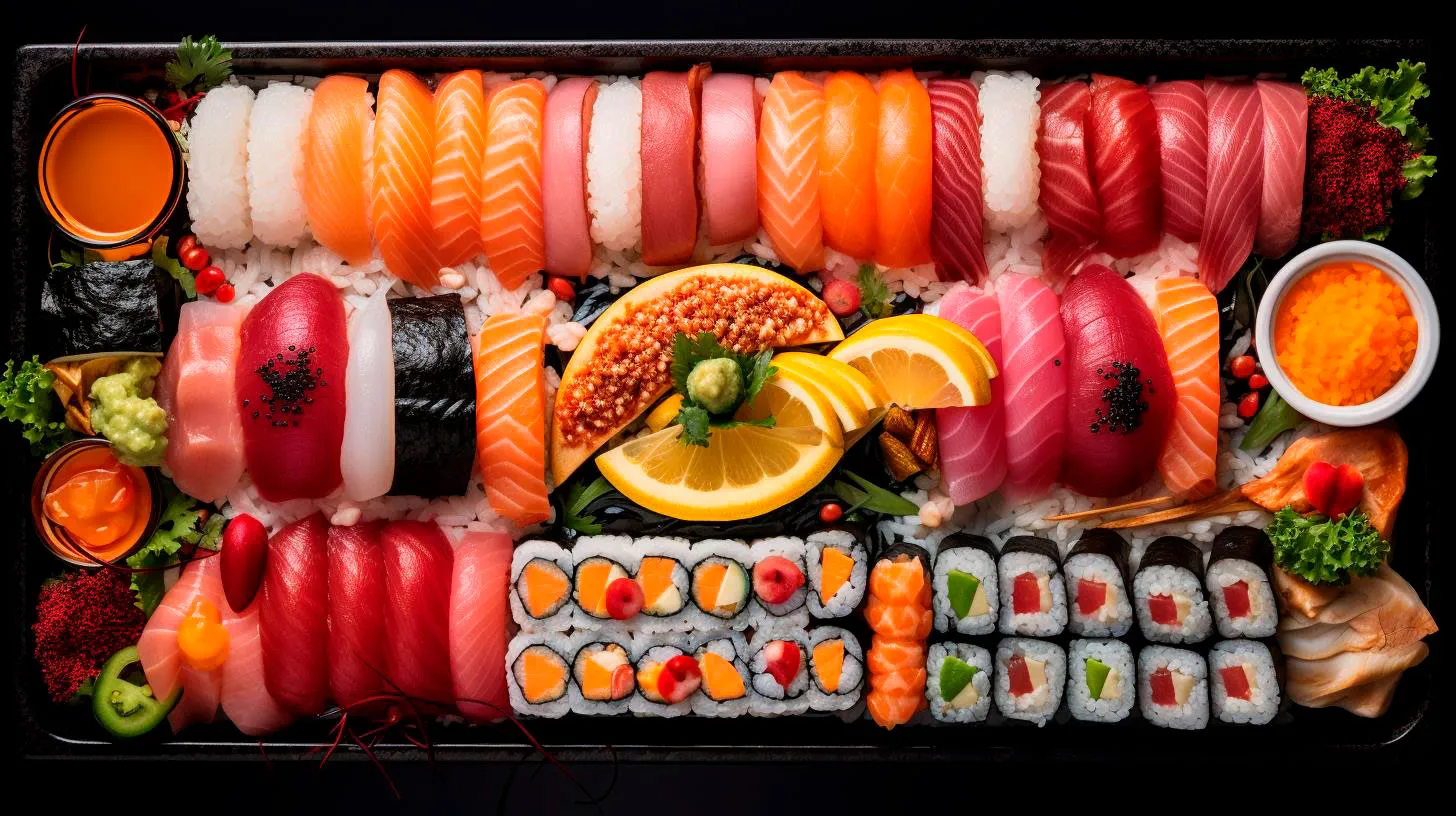Innovative Techniques Exploring Molecular Gastronomy in the World of Sushi
Molecular gastronomy, the scientific approach to cooking, offers chefs a new dimension to enhance flavors, textures, and presentations. Through this revolutionary approach, sushi chefs have been able to create unique dining experiences and surprise their guests with inventive creations.
Let’s delve into the world of molecular gastronomy and explore some of the innovative techniques that have been embraced by sushi chefs across the globe.
Redefining Flavor Profiles
Molecular gastronomy offers sushi chefs the tools to experiment with flavors and create surprising combinations. By leveraging scientific principles and techniques, chefs can extract essences, infuse flavors, and alter the taste profiles of traditional sushi components.
- Essence extraction: Through the use of cutting-edge distillation methods, molecular gastronomy allows chefs to extract essences from various ingredients like miso, soy sauce, or even seaweed. These essences can be used as concentrated flavor enhancers in sushi preparations.
- Flavor pairing: The concept of flavor pairing, popular in molecular gastronomy, helps chefs discover unusual but harmonious flavor combinations. For example, infusing sushi rice with the fragrance of truffles or adding a hint of citrus to a classic salmon nigiri can elevate the taste experience.
- Temperature manipulation: By playing with temperatures, sushi chefs can create new tastes. Liquid nitrogen is often used to freeze ingredients instantly, resulting in unique textures and flavor contrasts in sushi rolls.
These techniques allow chefs to rethink traditional sushi flavors, creating innovative dishes that surprise and delight diners.
Transforming Textures
Texture plays a crucial role in the culinary experience, and molecular gastronomy has opened up a world of possibilities for sushi chefs to experiment with unique textures in their creations.
- Spherification: This technique, popularized by molecular gastronomy, involves encapsulating liquids into gelatinous spheres, creating a burst of flavor when bitten into. Sushi chefs can employ this method to present small bursts of flavor, such as spherical soy sauce droplets, within their sushi rolls.
- Air-infused ingredients: Using techniques like foams and emulsions, sushi chefs can incorporate air and create lighter, more delicate textures. Air-infused avocado puree or a wasabi foam adds a velvety mouthfeel that adds a new dimension to sushi rolls.
- Trompe-l’oeil: By using gelling agents and molds, sushi chefs can create visually stunning yet tasteful illusions. This technique allows them to imitate the look of ingredients like caviar or roe, using edible alternatives made from various ingredients.
These transformative techniques enable sushi chefs to surprise their guests with visually appealing and texturally intriguing creations.
Elevating Presentations
In the world of sushi, presentation is as important as taste. Molecular gastronomy techniques offer sushi chefs the ability to create visually stunning presentations that engage all the senses.
- Gelification: Through the use of gelling agents like agar-agar or xanthan gum, sushi chefs can turn liquids into gel-like textures. This technique can be used to create visually appealing cubes or spheres, adding an artistic touch to the presentation of sushi.
- Edible films: Chefs can use edible films made from ingredients like nori or soy to wrap around sushi rolls, creating visually striking presentations. These films can be flavored or colored to further enhance the overall dining experience.
- Smoke infusion: Molecular gastronomy techniques like smoke infusion allow chefs to add smokey flavors to sushi, creating a sensory experience for diners. Using smoking guns or cloches, sushi chefs can infuse rolls with subtle smokiness, imparting depth to the dish.
With these creative presentation techniques, sushi chefs can elevate the visual appeal of their dishes, making them a feast for the eyes as well as the taste buds.
The Key Takeaways
Molecular gastronomy brings innovation to the world of sushi by offering chefs new techniques to explore flavor profiles, transform textures, and elevate presentations. By embracing these techniques, sushi chefs can create unique dining experiences that surprise and delight their guests.
Key Takeaways:
- Molecular gastronomy allows chefs to extract essences, infuse flavors, and manipulate temperatures, redefining traditional sushi flavor profiles.
- Spherification, air-infused ingredients, and trompe-l’oeil are techniques that transform the textures of sushi, creating unexpected and delightful mouthfeel.
- Gelification, edible films, and smoke infusion are presentation techniques that visually elevate the sushi dining experience.
Embracing the principles of molecular gastronomy, sushi chefs can continue to push the boundaries of creativity and surprise diners with their innovative sushi creations. By combining tradition with scientific techniques, the world of sushi is constantly evolving, offering a truly unique and unforgettable culinary adventure.
Creating a Multi-Sensory Experience Incorporating Food Science in Sushi Plating
By understanding the science behind how our senses perceive food, chefs are taking sushi to a whole new level, tantalizing not only our taste buds but also our other senses.
The Science Behind Multi-Sensory Sushi
When it comes to creating a multi-sensory experience, understanding the science behind our senses is essential. By appealing to sight, smell, taste, touch, and even sound, chefs can elevate the dining experience and create a lasting impression on their customers. Let’s explore the key aspects of this unique approach:
Visual Appeal
The saying “we eat with our eyes first” holds true in the world of sushi plating. Chefs are using various techniques to create visually stunning presentations that captivate their customers. By combining vibrant colors, contrasting textures, and artistic arrangements, sushi becomes a feast for the eyes. Notable visual aspects include:
- Use of edible flowers and microgreens to add color and visual interest.
- Artful arrangement of sushi rolls and nigiri to create visually appealing patterns.
- Contrasting colors of fish, rice, and garnishes to enhance the visual impact.
Scent and Aroma
The aroma of food plays a significant role in our overall dining experience. Savvy sushi chefs are incorporating aromatic ingredients to enhance the scent of their creations. This not only stimulates appetite but also adds complexity to the tasting experience. Key points to note:
- Use of aromatic herbs and spices, such as wasabi, shiso leaves, and ginger, to add fragrance.
- Smoking techniques, such as cedar plank smoking, to infuse a subtle yet distinct aroma.
- Experimentation with unique flavors, like truffle-infused soy sauce, to create an olfactory surprise.
Texture and Mouthfeel
Texture is an often overlooked aspect of food, but it plays a vital role in our eating experience. By incorporating different textures in a sushi dish, chefs can create a delightful and memorable mouthfeel. Consider the following:
- Combining crispy tempura, creamy avocado, and soft sashimi for contrasting textures.
- Using various textures of rice, such as vinegared rice, crispy rice, or sushi rice with added crunch.
- Playing with the texture of ingredients like crunchy tobiko, creamy mayo, or silky tofu.
Taste and Umami
Of course, taste remains paramount when it comes to sushi. However, by understanding the concept of umami – the fifth basic taste – chefs can create an even more rewarding dining experience. Umami adds depth, richness, and complexity to the flavors and can be enhanced through various techniques, including:
- Using umami-rich ingredients such as miso paste, soy sauce, and bonito flakes.
- Experimenting with flavor pairings, such as sweet and salty, sour and savory, to create a harmonious taste experience.
- Balancing flavors by incorporating acidic elements, like citrus or vinegar, to cut through richness.
The Benefits of Multi-Sensory Sushi Experience
The incorporation of food science in sushi plating brings numerous benefits to both customers and chefs alike. Let’s explore the advantages:
- Enhanced dining experience: By appealing to multiple senses, diners enjoy a more engaging and memorable meal.
- Increased customer satisfaction: The attention to detail and creative plating techniques leave a lasting impression and foster customer loyalty.
- Exploration of new flavors: Chefs can experiment with unique flavor combinations, expanding the culinary boundaries of traditional sushi.
- Differentiation in a competitive market: With the rising popularity of sushi, creating a multi-sensory experience sets restaurants apart from their competitors.
- Opportunities for collaboration: By collaborating with food scientists and sensory experts, chefs can delve deeper into the science behind taste perception and further elevate their craft.
In Conclusion
Sushi has evolved beyond its traditional roots, embracing the science of food to create a multi-sensory experience. With an emphasis on visual appeal, aroma, texture, and taste, sushi chefs are creating unforgettable dining experiences that delight all the senses. By incorporating food science into sushi plating, this culinary art form reaches new heights, pushing boundaries and captivating food enthusiasts around the world.
The Chemistry Behind Sushi: Unveiling the Secrets of Flavor Pairing
The answer lies in the chemistry behind it, particularly in the art of flavor pairing. In this article, we will delve into the science behind sushi to unravel its secrets and explore how certain flavors complement each other perfectly.
The Role of Umami in Sushi
Before diving into flavor pairing, it’s crucial to understand the concept of Umami. Often referred to as the fifth taste, umami is a Japanese term that translates to “pleasant savory taste.” It is a distinct flavor that adds depth and richness to dishes. Umami is present in ingredients such as seaweed, soy sauce, and fish, which are prominently featured in sushi. The presence of umami in sushi enhances the overall taste experience and leaves a lingering savory sensation on the palate.
Key Takeaways:
- Umami is the fifth taste and adds depth to sushi.
- Ingredients like seaweed, soy sauce, and fish are rich in umami.
The Science of Flavor Pairing
Flavor pairing involves combining ingredients that complement each other and create a harmonious balance. The art of flavor pairing is deeply rooted in science, specifically the study of aroma compounds and taste receptors. Scientists have identified numerous compounds that contribute to taste and aroma, and understanding how they interact is key to achieving the perfect flavor fusion.
One of the fundamental principles of flavor pairing is that ingredients with similar flavor compounds tend to pair well. For example, the nutty flavor compounds in avocado complement the earthy compounds in mushrooms, resulting in a delightful combination often found in sushi rolls. Similarly, the citrusy compounds in yuzu pair harmoniously with the fatty compounds in salmon, creating a refreshing and indulgent flavor.
Key Takeaways:
- Flavor pairing involves combining ingredients that complement each other.
- Similar flavor compounds result in harmonious flavor combinations.
The Role of Texture and Temperature
When it comes to sushi, flavor is not the only factor at play. Texture and temperature also play a crucial role in the overall dining experience. The contrast in textures, such as the crispness of cucumber against the softness of rice, adds a delightful dimension to the dish. Additionally, temperature variations, like the contrast between warm tempura and cool fish, create a sensory experience that further enhances the flavors.
Key Takeaways:
- Texture contrast adds depth to the dining experience.
- Temperature variations create a sensory delight.
Advancements in Sushi Flavor Pairing
Today, chefs and scientists alike are taking sushi flavor pairing to new heights with the help of technology. Artificial intelligence and machine learning algorithms are being used to analyze vast databases of ingredient combinations and identify novel pairings that were previously undiscovered. This innovative approach is revolutionizing sushi creation and pushing the boundaries of flavor possibilities.
Key Takeaways:
- Technology is being utilized to discover new flavor combinations in sushi.
- AI and machine learning are aiding in the evolution of sushi flavor pairings.
Conclusion
Sushi’s irresistible appeal stems not only from its culinary elegance but also from the intricate chemistry behind its flavors. The harmonious pairing of ingredients, the presence of umami, and the interplay of texture and temperature all contribute to the sushi experience. As sushi continues to evolve, so too will our understanding of the science behind its captivating flavors. Next time you savor a delectable sushi roll, take a moment to appreciate the secrets it holds, and the chemistry that goes into creating such a remarkable culinary masterpiece.
The Art of Sushi Presentation: Perfecting the Plating Techniques
In this article, we delve into the techniques and principles behind perfecting the art of sushi plating.
Importance of Sushi Presentation
Sushi is not just a dish; it is a work of art that showcases the skill and creativity of the sushi chef. The way sushi is presented on the plate reflects the chef’s attention to detail, precision, and craftsmanship. A beautifully presented sushi platter not only captivates the diners but also elevates their perception of the quality and freshness of the ingredients used.
Moreover, in today’s digital age, where food photography and sharing on social media platforms have become immensely popular, a visually striking sushi presentation can create a buzz and attract more customers to your sushi restaurant. Stunning sushi plating has the power to leave a lasting impression on customers and make them want to come back for more.
Key Principles of Sushi Plating
1. Balance and Harmony: A well-plated sushi dish should exhibit balance in colors, textures, and flavors. The combination of vibrant colors and contrasting textures creates visual interest and makes the dish more appetizing. It is essential to strike a harmonious balance between the ingredients to ensure a well-rounded flavor profile.
2. Proportions and Geometry: Sushi is all about precision, and the same applies to plating. Pay attention to proportions and create geometric patterns for an aesthetically pleasing presentation. Uniformly cut ingredients, perfectly shaped rolls, and consistent spacing add a professional touch to your sushi platter.
3. Ingredients and Seasonality: To create visually stunning sushi, it is crucial to use fresh, high-quality ingredients that are in season. Freshness enhances the flavors and colors of the sushi, making it more visually appealing. Take advantage of seasonal ingredients to showcase the variety and versatility of your sushi creations.
Techniques to Elevate Sushi Plating
1. Colorful Garnishes: Adding vibrant and contrasting garnishes can bring life to your sushi presentation. Utilize ingredients like microgreens, edible flowers, citrus zest, and colorful sauces to create eye-catching accents. These garnishes not only enhance the visual appeal but also add subtle flavors and textures to the dish.
2. Plate Selection: Choose your plates wisely; they act as a canvas for your sushi art. Opt for simple and minimalist plates that allow the sushi to take center stage. Consider the color, shape, and size of the plate for a well-composed presentation.
3. Sauce Application: Master the art of sauce application to add artistic flair to your sushi plating. Use squeeze bottles or small spoons to create intricate designs or drizzle sauces strategically to complement the sushi rolls. Patterns like zigzags, dots, or swirls can instantly elevate the visual appeal of your dish.
Advantages of Perfect Sushi Presentation
- Enhances the dining experience by engaging multiple senses
- Influences customer perception of quality and freshness
- Creates buzz and attracts customers through social media sharing
- Increases the aesthetic appeal of the dish
- Leaves a lasting impression on diners
Key Takeaways
The art of sushi presentation is not solely about arranging ingredients on a plate; it is a form of creative expression that requires precision and attention to detail. A visually appealing sushi platter can enhance the dining experience, captivate customers, and leave a lasting impression. By following the key principles, experimenting with techniques, and paying attention to the overall visual balance, you can perfect the art of sushi plating and take your sushi creations to a new level.


